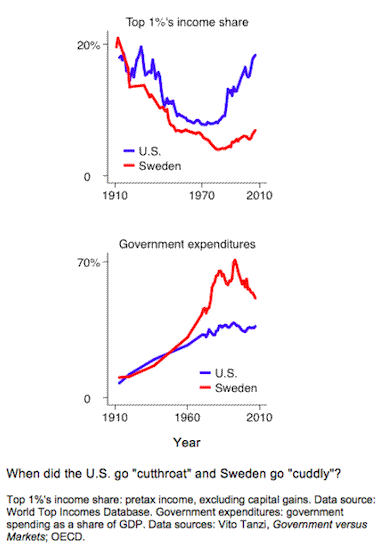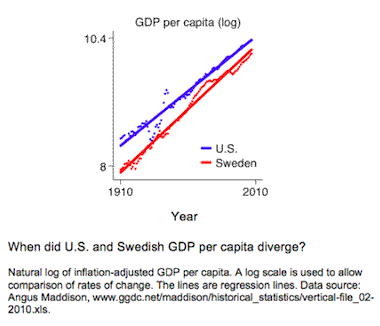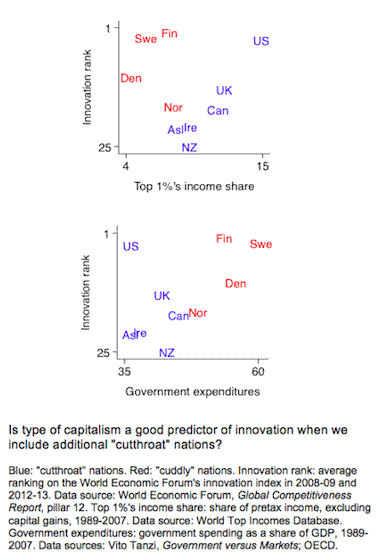Daron Acemoglu, James Robinson, and Thierry Verdier have a new paper that asks “Can’t We All Be More Like Scandinavians?” Their answer is no. The answer follows from a model they develop in which
- Countries choose between two types of capitalism. “Cutthroat” capitalism provides large financial rewards to successful entrepreneurship. This yields high income inequality, but it stimulates lots of entrepreneurial effort and hence is conducive to innovation. “Cuddly” capitalism features less financial payoff to entrepreneurs and more generous cushions against risk. This yields modest income inequality but less innovation.
- Because of the difference in innovation, economic growth initially is faster in cutthroat-capitalism nations. But technological advance spills over from cutthroat nations to cuddly ones, so growth rates then equalize. Over the long run, GDP per capita is higher in cutthroat-capitalism nations (due to the initial burst) while economic growth rates are similar across the two types.
- Average well-being may be higher in cuddly countries because the more egalitarian distribution of economic output more than compensates for the lower level of output.
- Nevertheless, it would be bad for all countries if cutthroat-capitalism nations switched to cuddly capitalism. That would reduce innovation in the (formerly) cutthroat nations, which would reduce economic growth in all nations.
Acemoglu, Robinson, and Verdier say the model might help us understand patterns of economic growth and well-being in the United States and the Nordic countries — Denmark, Finland, Norway, and Sweden. The United States chose cutthroat capitalism, while the Nordics chose cuddly capitalism. The U.S. grew faster for a short time, but since then all five countries have grown at the roughly same pace. America’s high inequality encourages innovation. The Nordics can be cuddly and still grow rapidly because of technological spillover. If the U.S. were to decide to go cuddly, innovation would slow. Both sets of nations would grow less rapidly.
Incentives, innovation, and economic growth in the U.S. and Sweden
I won’t provide the “detailed empirical study of these issues” that Acemoglu and colleagues say they hope their paper will inspire, but I can offer a little data. To keep things simple, I’ll compare the United States with just one of the Nordic countries: Sweden.
An indicator of financial incentives for entrepreneurs is the top 1%’s share of household income. An indicator of the extent of cushions against risk is government expenditures’ share of GDP. What we see in the data is a lot of similarity between the U.S. and Sweden until the second half of the twentieth century. Government spending begins to diverge in the 1960s, income inequality in the 1970s.

Though Sweden’s top 1% get a smaller share of the total income than their American counterparts, are incentives for entrepreneurs really much weaker in Sweden? Swedish CEOs and financial players don’t pull in American-style paychecks and bonuses in the tens of millions, but there is little to prevent an entrepreneur from accumulating large sums. In the 1990s Sweden undertook a significant tax reform, reducing marginal rates and eliminating loopholes and deductions. Corporate income and capital gains tax rates were lowered to 30%, and the personal income tax rate to 50%. Later the wealth tax was done away with. In the early 2000s a writer for Forbes magazine mused that Sweden had transformed itself from a “bloated welfare state” into a “people’s republic of entrepreneurs.”
But set this aside for the moment. Suppose the incentives for entrepreneurs did begin to differ in the two countries around 1960 or 1970. The model predicts innovation will subsequently diverge. Acemoglu, Robinson, and Verdier refer to one measure of patent applications per capita that has the U.S. leading Sweden beginning in the late 1990s. That timing perhaps is consistent with the model’s prediction if we allow a substantial lag. But they cite another measure that is available starting in 1980 and has the U.S. well ahead of Sweden already by then. This suggests America’s innovation advantage might have preceded rather than followed the two countries’ type-of-capitalism choice.
The final outcome is GDP per capita. Here the model stumbles. The gap between the two countries isn’t recent; it dates back to more than a century ago. Apart from a few hiccups, each country has stayed on its long-run growth path throughout the past 100 years, with Sweden slowly catching up to the United States.

So the U.S. and Sweden have chosen different styles of capitalism, at least as measured by income inequality and public spending. That choice looks to have occurred around 1960 at the earliest. The U.S. may be the more innovative of the two nations, and that advantage may have come after the type-of-capitalism choice. But the model doesn’t seem to help in explaining the gap between the two countries in per capita GDP.
Will American innovation slow if we go “cuddly”?
The really interesting question posed by Acemoglu, Robinson, and Verdier is whether innovation would slow in the United States if we strengthened our safety net and/or reduced the relative financial payoff to entrepreneurial success. I’m skeptical, for three reasons.
The first flows from America’s past experience. According to Acemoglu et al’s logic, incentives for innovation in the U.S. were weakest in the 1960s and 1970s. In 1960 the top 1%’s share of pretax income had been falling steadily for several decades and had nearly reached its low point. Government spending, meanwhile, had been rising steadily and was close to its peak level. Yet there was plenty of innovation in the 1960s and 1970s, including notable advances in computers, medical technology, and others.
Second, the Nordic countries, with their low income inequality and generous safety nets, currently are among the world’s most innovative countries. The World Economic Forum’s Global Competitiveness Index has consistently ranked them close to the United States in innovation. The most recent report, for 2012-13, rates Sweden as the world’s most innovative nation, followed by Finland. The U.S. ranks sixth. The 2012 WIPO-Insead Global Innovation Index ranks Sweden second and the United States tenth. Whether or not this lasts, it suggests reason to doubt that modest inequality and generous cushions are significant obstacles to innovation.
Third, if Acemoglu and colleagues are correct about the value of financial incentives in spurring innovation, we should see this reflected not only in the United States but also in other nations with relatively high income inequality and low-to-moderate government spending, such as Australia, Canada, Ireland, New Zealand, and the United Kingdom. But we don’t.

There’s one additional possibility worth considering. If financial incentives truly are critical for spurring innovation, it could be the opportunity for large gains that matters, rather than the absence of cushions. Suppose we were to increase government revenues in the United States via higher taxes on everyone — steeper income taxes on the top 1% or 5% plus a new national consumption tax. And imagine we used those revenues to expand public insurance and services — fully universal health insurance, universal early education, a beefed-up Earned Income Tax Credit, a new wage insurance program, more individualized assistance with training and job placement. These changes wouldn’t alter income inequality much, but they would enhance economic security and opportunity. Would innovation decline? I doubt it.
We may get a test of this moderate-to-high inequality with generous cushions scenario at some point. I suspect this is where America is heading, albeit slowly. Interestingly, the Nordic countries, where the top 1%’s income share has been trending upward (see figure 10 here), might end up there first.
- Bulenox: Get 45% to 91% OFF ... Use Discount Code: UNO
- Risk Our Money Not Yours | Get 50% to 90% OFF ... Use Discount Code: MMBVBKSM
Disclaimer: This page contains affiliate links. If you choose to make a purchase after clicking a link, we may receive a commission at no additional cost to you. Thank you for your support!



Leave a Reply